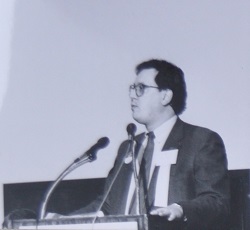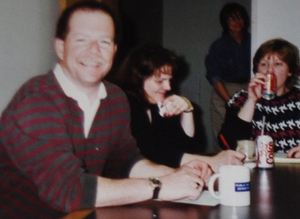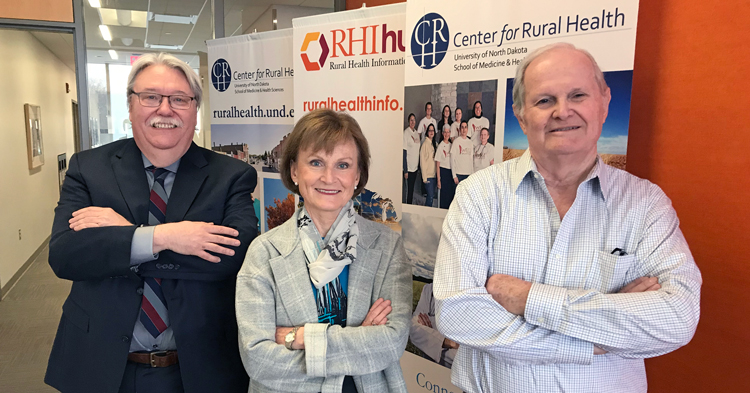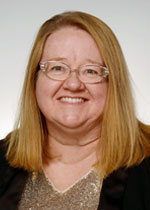The Big 4-0
From Its Humble Beginning, CRH Has Worked to Improve Health in Rural and Tribal Communities
By Brenda Haugen on
If you ask any of the former directors what has made the Center for Rural Health (CRH) successful for the last 40 years, you'll likely get several answers. But one thing they'll all agree upon is that at the heart of the CRH is a committed group of people all working toward the same goal – connecting resources and knowledge to strengthen the health of people in rural and tribal communities.
The folks here, they work really hard. They're dedicated, there's a mission that people feel, and they work toward that.
"We have a great staff and faculty here," said Gary Hart, who has served as the CRH director since 2010. "I think one of the great things is that very few people have left, and we've kept a real strong core of all of our programs. All of these national centers that we have, those people who were here when I got here are still here, and their centers are doing really well. The folks here, they work really hard. They're dedicated, there's a mission that people feel, and they work toward that."

Because the CRH is mainly a grant-funded operation within the University of North Dakota School of Medicine & Health Sciences, it has a little more latitude than other programs may have to be creative in finding solutions for the communities it serves.
I've always subscribed that the Center for Rural Health is basically a form of public entrepreneurship.
"I've always subscribed that the Center for Rural Health is basically a form of public entrepreneurship," said CRH Deputy Director Brad Gibbens, who has been with the CRH for 34 years. "We find problems, we come up with solutions, and we try to find money to address those problems. We are not locked into a box where we can do only the things that our state office of rural health grant can support. So again, it's part of that environment that's very supportive and conducive to innovation. You have an idea. It's a good idea. Let's try to find some funding."
In the Beginning
That entrepreneurial spirit has been with the CRH from the start. In the late 1970s, Dr. Robert C. Eelkema, chair of the Department of Community Medicine at the University of North Dakota School of Medicine, envisioned a new way to address the lack of providers in rural and underserved areas. Eelkema pitched the idea to Tom Johnson, who was dean of the medical school. Agreeing it was a good idea, Johnson and Eelkema presented the concept to the North Dakota Legislature. With a $73,000 allocation, the CRH was established in 1980. It was one of just five in the country. Today, all 50 states have an office of rural health.

Johnson approached Kevin Fickenscher, a 1978 graduate of the UND medical school, to be the CRH's founding director. At the time, Fickenscher was working in New York, but the idea of coming back to North Dakota and shaping this new program intrigued him. "To me it seemed like the ultimate social medicine project because I was going to be coming back home, and I was given this very broad charge of 'solve rural health problems,'" Fickenscher said.
So we were going to help make healthcare better. That was my overriding philosophy.
Fickenscher accepted the challenge and became the CRH's first and only employee at that time. From the very start, Fickenscher didn't want the CRH to be a traditional academic research program. "I wanted us to help the people of North Dakota," he said. "So we were going to help make healthcare better. That was my overriding philosophy."
He didn't know exactly what that meant, so he visited physicians in rural North Dakota. He also reached out to legislators across the state. He asked all of them what they wanted his office to do. "The clear message was if you sit in Grand Forks, you're not going to help us. So don't sit in Grand Forks," Fickenscher said.
So Fickenscher traveled the state. The CRH worked with rural hospitals to help them find ways to continue developing and sustaining healthcare services for area residents. It also looked at workforce issues and became involved in a successful, albeit unusual, physician recruitment program. "We had some slightly different approaches," Fickenscher said with a chuckle. "For example, our recruiters had a contest for a couple of docs to see if they could get them married off locally so that after we recruited them we could keep them. So we did things like that. It was a lot of fun." Among the first events held by the CRH was the Dakota Conference on Rural and Public Health. The first Dakota Conference was held in 1984. Since its inception, the conference has provided an opportunity for healthcare professional, educators, and students to share strategies for building and sustaining healthy communities in North Dakota.
Because of the work going on in North Dakota, several of the surrounding states reached out to the CRH, giving it a more regional focus. By the time Fickenscher moved on from the CRH after nine years with the program, it included 15 staff members, a $1.8 million budget, and a number of projects.
A Time of Growth

Originally from New York City, Jack Geller first came to UND to fill in for a Sociology Department faculty member who was on a one-year sabbatical. With an academic interest in rural issues, it seemed natural that Geller would gravitate toward the CRH despite his urban roots. In time, at the invitation of Fickenscher, Geller came to the CRH as its research director.
"The Center for Rural Health was doing some modest amount of research, but most of this focus was service to rural communities, rural healthcare facilities," Geller said. "So there was a very large service staff, people who were going in all across rural North Dakota, but research capacity and research expertise was modest."
After Fickenscher left, Geller became the CRH's director in 1990, serving until 1996. Though he had a background in research, the main goals of the CRH stayed true.
"I don't think by that time my focus was really changed. I think it would be more appropriate to say the mission of the center actually grew and expanded," Geller said. "So in addition to its continuing commitment to actual service, physician recruitment, and, to a modest extent, trying to engage with medical students in the value and the virtue of rural practice, we also then had a component which was pretty fixed by the time Kevin left because we had become shortly after I arrived one of seven national health research centers in the country funded by the federal government. That kind of gave us entrée into a broader network of researchers that the center hadn't had before, but I don't think it lessened in any way the service commitment to rural North Dakota communities, hospitals, physicians, and...the recruitment of physicians to rural North Dakota practice."
Along with branching out the research and service agenda, the CRH delved into gerontology and Native American aging pursuits, Geller said. With that program growth came the need to add more staff. The growth that happened at the CRH occurred with the support of the university. People at UND understood the value of the CRH and allowed it to take risks and to grow, Geller said.
People like Tom Clifford, when he was president, understood the value of a place like the Center for Rural Health.
"At UND there was a university-wide commitment," he said. "People like Tom Clifford, when he was president, understood the value of a place like the Center for Rural Health. The Dean of Medicine Tom Johnson at that time, Clayton Jensen, a number of really strong deans who followed, they all [supported us] as well. There was a commitment university-wide to this center that I don't think really existed in many other universities that may have been getting an equal amount of grant dollars, but if those grant dollars went away or lessened, the university didn't have that overall commitment. That [commitment] was there at UND, and I think that really made the difference. That allowed [the CRH] to flourish. That allowed it to take risks [and] to expand services."
The CRH continued to grow after 1996 when Geller left. Brad Gibbens, who'd been serving as associate director, stepped in as the interim director, a position he'd hold for about five years until Mary Wakefield was named director in 2001.

"My agenda was basically maintain operations, continue to expand based on our core programs, which is what we did," Gibbens said. "I think one of the things that has always been part of the landscape for rural health has been the viability of rural hospitals, so we continued our work in addressing rural hospital issues, doing assessments, doing strategic planning."
In the late 1980s and early 1990s, a number of rural hospitals across the country closed, including 10 in rural North Dakota. "So I was really doing a lot of national work, working with our congressional offices and helping them understand what the issues were and being able to look at various options and trying to build momentum around what we've commonly called an alternative hospital model, and that's really what the Critical Access Hospital was," Gibbens explained.
During this same period, the CRH secured funding to start a rural Emergency Medical Services (EMS) program. "EMS has always been a focus within the Center for Rural Health," Gibbens said. "It has a lot of impact right now, but really our work in EMS goes back to the late 1980s."
Like EMS, other issues have remained a focus of the CRH since its inception. "Health workforce was [important from] day one at the Center for Rural Health 40 years ago, and it still is today one of our dominant issues in the viability of maintaining rural health systems, particularly the hospitals and clinic structure," Gibbens said.
Picking Up the Pace
"We thought we'd been clipping along at a pretty fast pace until Mary got here, and then we discovered what fast meant," Gibbens said with a smile. "That was an amazing seven-year period for the center and also for myself, working for Dr. Wakefield – a truly amazing, intelligent person who was looking for the next big thing to address. We spent a fair amount of time just trying to keep up with her and trying to put in place some of the things she was looking at."
Mary Wakefield was named CRH director in 2001. Her connections at the national level, including having served for senators Quentin Burdick and Kent Conrad, proved invaluable to the CRH.
"I was really interested in strengthening ties within the state to rural communities and to rural healthcare infrastructure," Wakefield said. "That presence was already there, but I really wanted to execute on that agenda of being a real resource to the communities and to the healthcare infrastructure."
We really amped up in that area doing research that focused on some issues right here in North Dakota.
She also wanted to focus on education. "When we could, we would talk with...health profession students about opportunities in medicine, nursing, and other health careers to try to strengthen those interests in working in rural communities," she said. "And research scholarship was a big focus. We really amped up in that area doing research that focused on some issues right here in North Dakota."
But the center didn't focus just on North Dakota. Wakefield said the CRH expanded to regional, national, and international research efforts as well. Just one example is federal funding secured for veterans' health issues. Another is the Rural Health Information Hub.
"Through a lot of hard work of staff, we really strengthened our national presence...through some key programmatic areas, one of them being at that time the Rural Assistance Center, now the Rural Health Information Hub," Wakefield said. "That was a major foray into really positioning this Center for Rural Health, this university, and this rural state as a go-to place for a rich repository of information that was national and expertise to be used and available to people across the United States from policymakers in Washington to individuals in Alaska who might be interested in more information about rural policy, new rural research findings, etc. So that was a major coup, if you will, but I had no hesitation about making a play for that federally funded initiative because my sense was that you could do rural health really anywhere."
Even though she moved on from the CRH in 2009, Wakefield said the center is still a valuable resource for her. "I think the center is incredibly fortunate to have of the experts that they have, the technology, the support from the state, and the support from the University of North Dakota to do the really important work that they do," she said, "again not just for people in North Dakota, although that to me was always first priority, but to inform health across the country."
A Respected Organization
When he was named director the CRH in 2010, Gary Hart already was familiar with the organization and its staff, which now numbers more than 50. Knowing the CRH's reputation, deciding to come here wasn't a tough decision.
I'd had a long history of working with people here through several directors and of course, this rural center here clearly was one of the preeminent ones in the country.
"I'd had a long history of working with people here through several directors and of course, this rural center here clearly was one of the preeminent ones in the country," Hart said. "And I knew...it would be a good place."
Gibbens said he's not only proud of the success of the CRH but also that the center's work has been seen as so valuable that it's been replicated in other places.
"In 1986 we had received a grant from the Bush Foundation, $500,000, that we used to create our first research efforts at the Center for Rural Health, Gibbens recalled. "Somebody from the Federal Office of Rural Health Policy had come out after that and started looking at what we were developing here in North Dakota. It was Jerry Coopey, who is really one of the true superheroes and architects of rural health at the national level. So Jerry really liked that idea, and he brought it back to the feds, and they said, 'Research in rural health, there's something there.' And it was from that idea, by looking at what we were doing here, they came up with the structure for the Rural Health Research Center grants, and again the Center for Rural Health was one of the first generation. But Jerry always gave us credit for really starting that idea."
Coopey also looked at what the CRH was doing at the state level. He and Pat Hart of the CRH mapped out what the core functions would be for an office of rural health and that became the State Office of Rural Health grant program, Gibbens said.
"So we've been given credit, because of the efforts that got started in North Dakota first, with developing or being the impetus for the creation of the Rural Health Research Program and the State Office of Rural Health program," Gibbens said. "So I'm pretty proud of that."
He's also proud of the fact that the CRH has gained a reputation for getting things done. "Success breeds success," Gibbens said. "So you go from a period where you're constantly trying to find a funder to a point where sometimes funders come to you. We've done things for the Commonwealth Fund and other groups where they have come to us and said, 'We have an idea. Do you think you guys can carry it out?' That's a nice position to be in."


 was a communications specialist at the Center for Rural Health at the University of North Dakota School of Medicine & Health Sciences in Grand Forks.
was a communications specialist at the Center for Rural Health at the University of North Dakota School of Medicine & Health Sciences in Grand Forks.



